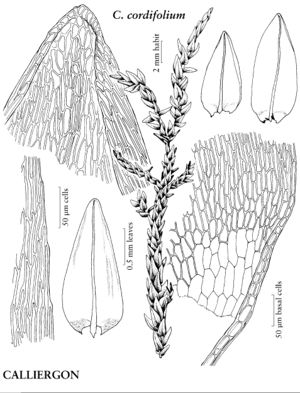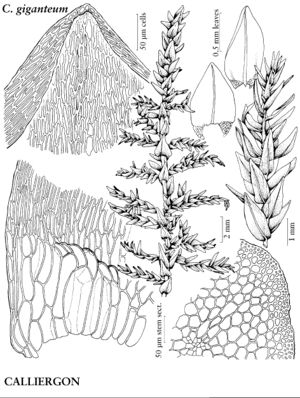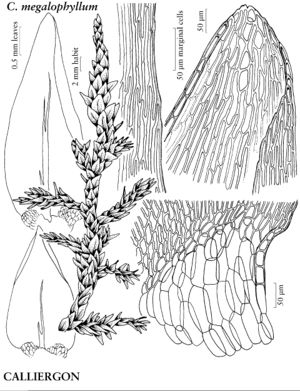Calliergon
Canad. Rec. Sci. 6: 72. 1894.
| Taxon | Illustrator ⠉ | |
|---|---|---|
 | Calliergon cordifolium | Patricia M. Eckel |
 | Calliergon giganteum | Patricia M. Eckel |
 | Calliergon megalophyllum | Patricia M. Eckel |
| ... further results | ||
Plants medium-sized to very large, green, pale green, yellowish, brownish, or sometimes pale-pink. Stems ± densely radially branched; hyalodermis absent, central strand present; outer pseudoparaphyllia broad, apex rounded to acuminate or cleft; rhizoids or rhizoid initials at various points on leaves, or on scattered points or in rows on stem; axillary hairs well developed, many, distal cells 2–8 (–10), hyaline. Stem-leaves ± broadly ovate to broadly rounded-triangular, abruptly narrowed to apex, straight, concave or strongly so, not plicate; base broadly decurrent; margins entire or occasionally slightly sinuate; apex rounded or obtuse; costa single, ending just before apex, or branched to 2-fid and ending 1/2–9/10 leaf length; alar cells differentiated, rectangular to long-rectangular, strongly inflated, hyaline, walls thin, region distinctly or indistinctly delimited, transversely triangular to broadly ovate; medial laminal cell-walls incrassate or thin, porose or not. Sexual condition dioicous or autoicous; inner perichaetial leaves not plicate; vaginula naked. Capsule with annulus not separating; exostome external surface reticulate basally, margins dentate distally. Spores 13–31 µm.
Distribution
North America, South America, Eurasia, Pacific Islands (New Zealand)
Discussion
Species 5 or 6 (5 in the flora).
Calliergon is recognized by the robust shoots and straight, ovate to broadly cordate leaves with rounded or broadly obtuse apices. Except for expressions of C. giganteum with a pink hue, red pigment is absent. The alar regions are well developed and in some species very large, and consist of inflated and hyaline cells. Rhizoid initials are frequent in the leaves, and the axillary hairs are large and abundant. Except for C. megalophyllum, which mostly grows submerged or in reed or sedge belts along lakeshores, the plants typically occur in somewhat nutrient-rich and relatively mineral-rich wetlands, such as fens and swamps. Weak expressions, especially of C. cordifolium, could be confused with Sarmentypnum sarmentosum or Straminergon stramineum; such variants are discussed under these species. W. C. Steere (1941b) described C. aftonianum from fossil material of isolated branches. This is most likely a Calliergon species, albeit with a short or sometimes absent costa. Weakly developed costae occur also in weak plants of the species treated here. However, since J. A. Janssens and P. H. Glaser (1986) reported extant plants with short costae from North America, further studies are required to decide the relationships of C. aftonianum.
Selected References
None.
Lower Taxa
Key
| 1 | Alar regions indistinctly delimited | > 2 |
| 1 | Alar regions sharply delimited | > 3 |
| 2 | Alar regions from margins to costa or almost so; proximal laminal cells not markedly wider than distal cells; stem leaves ovate-cordate, triangular-ovate, or narrowly elongate- cordate. | Calliergon cordifolium |
| 2 | Alar regions from margins 65-80% distance to costa; proximal laminal cells to 2 times as wide as distal cells; stem leaves broadly ovate or broadly ovate-cordate. | Calliergon orbicularicordatum |
| 3 | Stem leaf costae (88-)95-282 µm wide at base, single, ending shortly before apex; alar regions from margins to costa or nearly so. | Calliergon giganteum |
| 3 | Stem leaf costae 53-119 µm wide at base, single, ending shortly before apex, or single, branched or 2-fid, ending 1/2-9/10 leaf length; alar regions from margins 35-80% distance to costa | > 4 |
| 4 | Sexual condition autoicous; stem leaf costae 1/2-9/10 leaf length, usually branched or distally 2-fid; axillary hair apical cell short- to long-linear. | Calliergon richardsonii |
| 4 | Sexual condition dioicous; stem leaf costae ending shortly before apex, single; axillary hair apical cell elongate-rectangular to short-linear. | Calliergon megalophyllum |